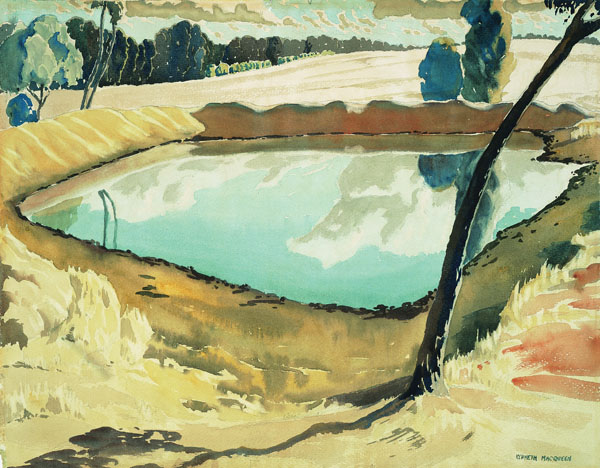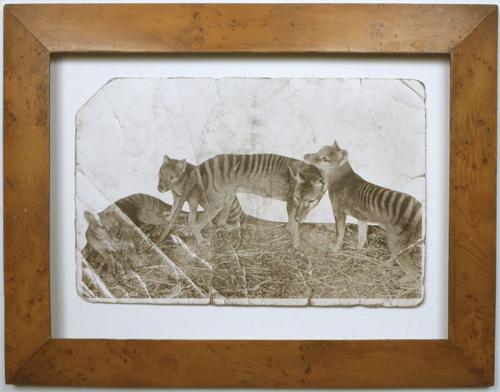
One of the first images in this exhibition is a deceptively simple, pale piece, a watercolour in high key, where the composition has been stripped back to broad, unambiguous planes. Titled Earthtank on the plains country (1924), the subject of the work is a man-made dam, a rectangular cut into the uncompromising flatness of a country that drawls endlessly on towards a horizon marked by a line of desultory trees. The sense of stillness, of monotony, of interminability has been reaffirmed by the artist; he has permitted little tonal variation in the colours, and the forms have been pared down to minimal shapes. The pallid sky might be preparing for the milky light of early dawn, and four embryonic cloud forms hover longingly above the crude rectangle of the tank. Central to the composition is a dead tree, little more than a line. Three waterbirds float to one side, and another etches the surface of the water with its own line. This is a painting of a country long inured to the habits of drought, and of the man-made ways of dealing with such conditions.
The work is described as having been gifted to friends who 'preferred his early work over the modern style' with which Kenneth McQueen has become associated, and yet the uncompromising directness and simplicity of the work are timeless, and a perfect introduction to the issues that occupied McQueen for the rest of his life. Those issues, establishing connections with land, landcare, water management, still loom as primary considerations right across Australia. It is possible to read the arid beauty of this unassuming painting as a kind of koan to the vexing questions surrounding land use in Australia to the present.
There is little doubt that this exhibition will not draw the crowds it deserves. These rooms of evenly spaced, similarly sized watercolours suggest an orderliness and predictablility associated with 'traditional' work, Queensland country life and the genteel skills of watercolour. Yet this is an exhibition that is scattered with surprises and little revelations. Although billed as an Australian modernist and 'the most distinctive watercolourist of his generation', McQueen's work remained inextricably linked to his role as a farmer. He produced sketches and photographs of the land during smoko breaks and wrote that he sought to 'combine (the life of) the artist with (the life of) the farmer so that I might paint only those things which please me'.
The close intimacy McQueen shared with the land owned by he and his brother Jack at Mt. Emlyn near Millmerran on Queensland's Darling Downs grant the best of these works a pantheistic presence. In Hills and Dam (1928), the sky is depicted as an upturned bowl hovering over the mechanised efforts of the ploughman. The tractor lifts a small, insubstantial puff of earth dust back up towards that sky, and the swell of the dark field upwards to the horizon suggests anthropomorphic interpretations. This sense of elegiac wonderment is a common thread, and this work shares the same kind of nod to the insubstantial efforts of man in the face of the timeless quality of the seasons and the land that we see in Breughel's The Fall of Icarus.
The small scale and the medium of watercolour do not suggest the magnitude of the themes McQueen's work addresses. His studies of skies and seas are often filled with a perceptive romanticism that has been born from studied observation rather than wild fantasy. And yet in a work such as Lagoon running out (1942) a simple scene of a sand bank run with rivulets and tide pools there is a sense of prophetic wonderment.
This is a big body of work which inevitably contains a scattering of weak spots; at their worst some works are prosaic, illustrative and coy, but overall the exhibition leaves us with a sense of an artist who had a huge vision of a relationship to land, sea and sky that is both local and vast in its ambit. At times there is something of Colin McCahon's stoic reverence, a sense of commitment to place that is far greater than the mere recording of data. Perhaps it is a mark of this era's demand for scale and volume that the full power of these works, and their potential contribution to understanding relationships with land, become most evident in the enlargements of the works that have been prepared to advertise the exhibition. One can only wonder about the extent to which McQueen's vision and stature will be overlooked by the tendency to identify him as a competent watercolourist.












